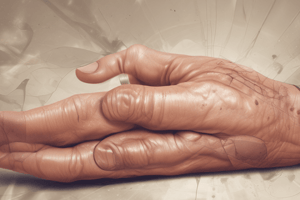Podcast
Questions and Answers
What term describes an accumulation of flakes or dandruff on the skin surface?
What term describes an accumulation of flakes or dandruff on the skin surface?
- Comedo
- Crust
- Scale (correct)
- Ulcer
Which of the following conditions is characterized by excessive shedding of hair?
Which of the following conditions is characterized by excessive shedding of hair?
- Hypotrichosis
- Hypertrichosis
- Effluvium (correct)
- Alopecia
What is the primary cause of leukoderma?
What is the primary cause of leukoderma?
- Lack of melanocytes (correct)
- Excess melanin production
- Increased melanocyte activity
- Overactivity of melanocyte-stimulating hormone
Which secondary lesion is characterized by a break in the epidermis exposing the underlying dermis?
Which secondary lesion is characterized by a break in the epidermis exposing the underlying dermis?
Hyperpigmentation is commonly described as an increase in what component from existing melanocytes?
Hyperpigmentation is commonly described as an increase in what component from existing melanocytes?
What condition results from the absence of hair due to failure to develop?
What condition results from the absence of hair due to failure to develop?
What describes a thickening and hardening of the skin with exaggeration of superficial markings?
What describes a thickening and hardening of the skin with exaggeration of superficial markings?
What type of hair abnormality is characterized by more hair than normal?
What type of hair abnormality is characterized by more hair than normal?
Which of the following describes a macule?
Which of the following describes a macule?
What is a significant characteristic of primary lesions?
What is a significant characteristic of primary lesions?
Which lesion is defined as a small, pus-filled elevation of the epidermis?
Which lesion is defined as a small, pus-filled elevation of the epidermis?
What is true about wheals?
What is true about wheals?
A bulla is differentiated from a vesicle by which of the following?
A bulla is differentiated from a vesicle by which of the following?
Which of the following describes a cyst?
Which of the following describes a cyst?
Abscesses differ from pustules in that abscesses typically:
Abscesses differ from pustules in that abscesses typically:
Which statement about nodules is correct?
Which statement about nodules is correct?
Flashcards are hidden until you start studying
Study Notes
Factors Causing Skin Injury
- External (exogenous) factors include environmental influences.
- Internal (endogenous) factors arise from within the body.
Types of Skin Lesions
- Primary lesions: Direct results of disease, crucial for diagnosis.
- Secondary lesions: Evolve from primary lesions, usually less diagnostically significant.
Primary Skin Lesions
- Macule: Discolored area, ≤ 1 cm; example: lentigo, a benign hyperpigmentation.
- Papule: Small, round, solid elevation, ≤ 1 cm in size.
- Plaque: Larger, flat-topped solid elevation of the skin.
- Nodule: Hard elevation, ≥ 1 cm, extends into deeper skin layers.
- Vesicle: Circumscribed elevation of < 1 cm filled with clear fluid.
- Bulla: Larger vesicle (> 1 cm) containing fluid within the epidermis.
- Tumor: Large mass implicating neoplasia, affecting skin or subcutis.
- Cyst: Epithelial-lined cavity with fluid or solid material.
- Pustule: Small, pus-filled elevation of the epidermis.
- Abscess: Accumulation of pus within epidermis or hair follicle.
- Wheal: Smooth, well-defined elevation from dermal edema, commonly seen in allergic reactions.
Secondary Skin Lesions
- Scale: Accumulation of flakes or dandruff on the skin surface.
- Crust: Dried exudate, blood, or serum accumulation.
- Comedo: Dilated hair follicle filled with cornified cells; often seen in conditions like hyperadrenocorticism.
Hair Abnormalities
- Alopecia: Loss of hair.
- Hypotrichosis: Less hair than normal.
- Atrichia: Absence of hair due to failure of development.
- Effluvium/defluxion: Excessive shedding.
- Hypertrichosis (hirsutism): More hair than usual; can be due to endocrine disorders.
Epidermal Pigmentation Alterations
- Hyperpigmentation: Increased melanin production, often due to inflammation or genetics.
- Hypopigmentation: Reduced melanin, can be congenital or due to melanocyte dysfunction.
- Pigmentation incontinence: Loss of melanin from the basal epidermis.
Secondary Lesion Characteristics
- Epidermal collarette: Circular rim of keratin flakes after vesicle/pustule loss.
- Ulcer: Break in the epidermis, exposing underlying dermis.
- Excoriation: Erosions or ulcers from scratching or trauma.
- Scar: Fibrous tissue replacing damaged skin.
- Fissure: Linear cracks in thickened, inelastic skin.
- Lichenification: Thickening and hardening of skin with visible superficial markings.
Studying That Suits You
Use AI to generate personalized quizzes and flashcards to suit your learning preferences.




